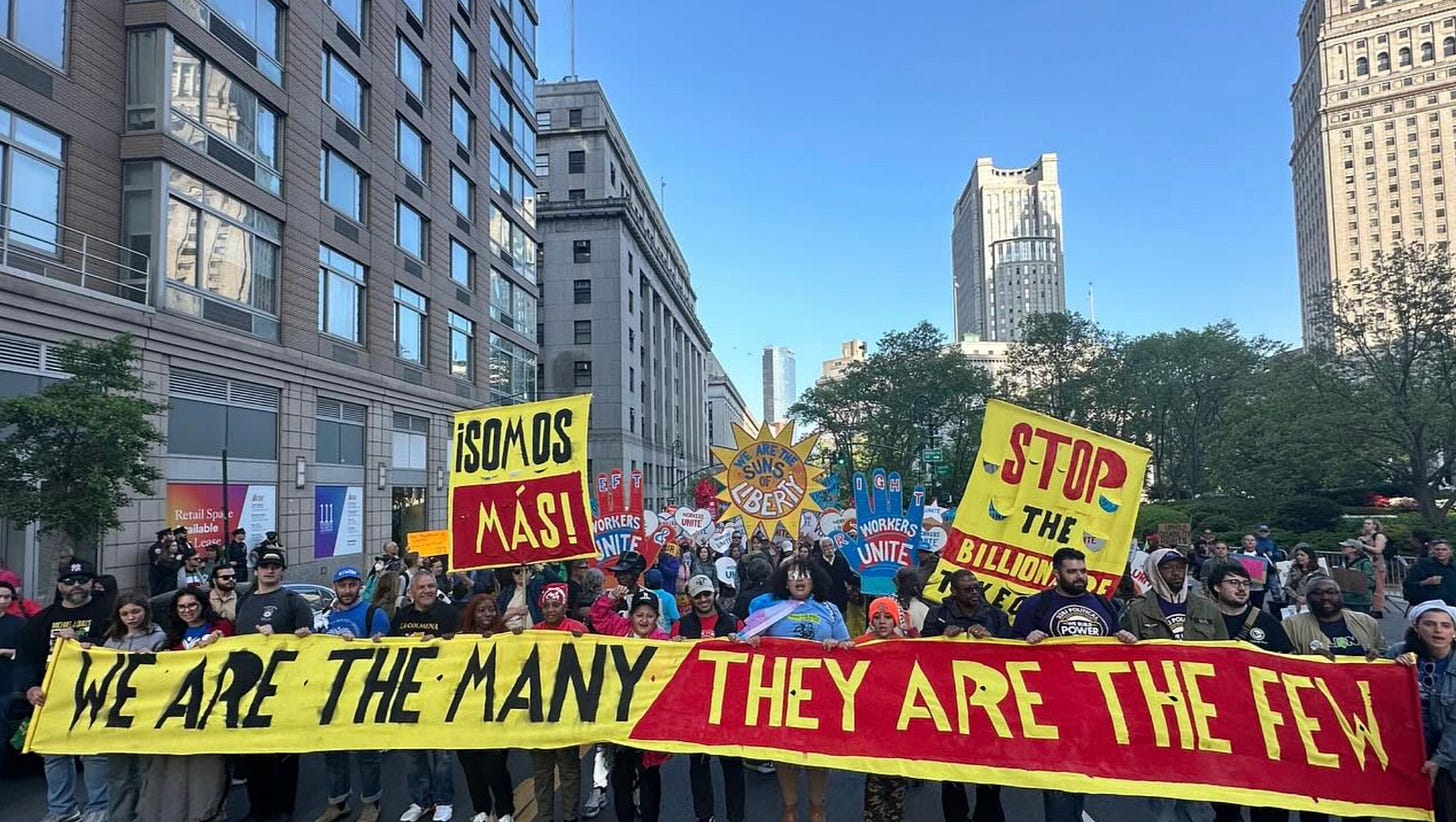Ancestors and Money: A 6-month coaching cohort
Before you read the article below, I wanted to share with you about a meaningful program run by my friends, Morgan Curtis and Justine Epstein. Ancestors and Money is a 6-month cohort for white people with significant inherited wealth longing to reckon with ancestral harm and take action toward redistribution and repair. Applications are accepted until June 1 or until the 15-person cohort is full.

May Day is my favorite holiday.
It is most known for being International Workers’ Day—a day that calls on all working and oppressed people to come together in common struggle.
The U.S. does not officially recognize May Day due to what many historians see as “an enduring resistance to working-class unity.” Yet this past Thursday saw the largest nationwide turnout for May Day demonstrations in U.S. history. Hundreds of thousands of people came together, reflecting a rising class consciousness and a growing recognition that our seemingly disparate movements are united within a broader class struggle. In every big city and even in many rural areas that “voted overwhelmingly” for Trump, people marched to protect unions, public schools, persecuted Palestine solidarity activists, programs like Medicare, Medicaid, and Social Security, trans and immigrant communities, and all of our democratic rights.
But International Workers’ Day isn’t the only May Day.
May 1st is also the date of a far older celebration. While it is identified most with Northern Europe, it is reflective of similar seasonal celebrations throughout the globe. Originally (and still sometimes) called Beltane, this ancient holiday is one meant to honor the earth and the changing phases of the agricultural year. The maypole itself is a symbol tied to these early communities’ reverence for trees. 2000 years ago, the peoples north of the Roman empire’s reach are said to have “worship[ped] the gods in the woods without using temples.”
Traditional English Morris dancers have for centuries awoken early on this day, adorned themselves with handkerchiefs and bells, and greeted the dawn with a series of step-dances to call in the warmer months.

For millennia, European commoners partook in an array of festivities and ceremonies on holydays like May Day that, as Barbara Ehrenreich has written, were suppressed first by the Church and then by the capitalists. Beginning in the sixteenth and seventeenth centuries, leaders of this new economic order sought to separate the peasantry from their land (to create the displaced and dependent workforce and settler force that their project required), to eliminate rest, ceremony, and festivity from these people’s lives (to create the cultural conditions for workplace exploitation to flourish), and to instill a sense of racial and religious superiority (to quell class antagonisms and prevent multiethnic coalitions from emerging in the colonies).
Yet these commoners didn’t easily allow their earth-based tradition or their political resistance to vanish.
When reading historian Peter Linebaugh’s The Incomplete, True, Authentic, and Wonderful History of May Day, I learned about a striking story that also happens to be depicted in the engraving pictured below. This image, created in 1850, illustrates a scene that took place on May Day in 1628. We see colonial leaders looking down disparagingly at the village of Merry Mount, a uniquely inclusive maroon society of sorts just outside of present-day Boston.
Merry Mount was started by Thomas Morton, a class traitor who rejected Puritanism’s conquest of English folk culture. It was a place where runaway indentured servants and other marginalized groups within the colonial system lived free and in close connection with their nearby Massachusett indigenous neighbors. The community was notorious among Puritan elites for its inclusivity, its egalitarian sharing of resources, its prioritization of multiethnic solidarity, its “pagan” practices, and its 80-foot maypole topped with deer antlers and strewn with garlands and ribbons that sat at the center of the village.
In this image, Europeans recently freed from indenture and Native people dance around the maypole on May Day together.

Linebaugh wrote that,
“Merry Mount became a refuge for Indians, the discontented, gay people, runaway servants, and what the governor called “all the scume of the countrie.”
Eventually though, settler-soldiers from the Plymouth colony would burn down the village and halt the dream of an alternative future that it represented.

The story of Merry Mount, like much of Linebaugh’s book, illustrates how these two different May Days are actually deeply connected.
To me, one May Day calls us to honor the earth around us and to revive our connection to community, to the meaningful traditions each of us comes from, and to the spirit that flows through all life. The other calls on us, as members of the global 99% (as well as comrades like Morton who come from wealth yet are committed to change), to overcome numerous forms of manufactured division and join together in a broad social movement.
It is each of these things—our connection to the sacred and our capacity for participation in mass political resistance—that capitalism, through propaganda and force, has sought to sever all of us from. I believe that May Day represents a portal for reclaiming both, each a vital tool for getting out of this mess.
I have faith that today, in this time of great upheaval, this portal is widening, and more and more of us will become inspired to step through it together.





Thank you for retelling this valuable history. As a child in the 60's rural Mississippi we celebrated May Day. We had Choctaw and Blacks that lived across the tracks. It may have been the last inclusive event occured there that I remember. I too enjoyed May Day. It's good to get these stories out.